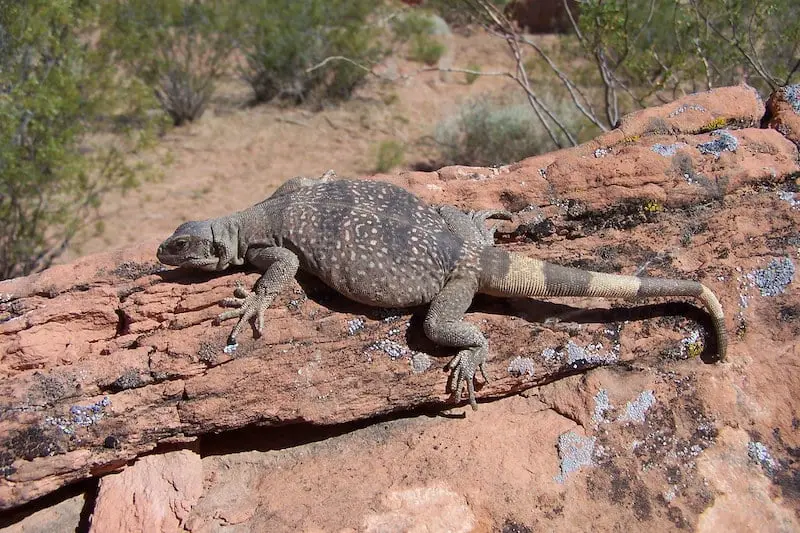Nevada’s deserts support some of the most resilient reptiles in the American West. From open basins filled with sagebrush to sun-scorched rock flats and rugged canyon slopes, these landscapes create conditions that only highly adapted animals can handle. Lizards are among the most successful survivors here, navigating extreme temperatures, scarce water sources, and unpredictable seasons with strategies shaped by thousands of years of evolution.
Many people notice them darting across gravel trails, basking on sun-warmed stones, or disappearing into crevices the moment a shadow passes. Yet their daily routines are far more complex than quick movements and bursts of energy. Nevada’s lizards rely on specialized physical traits and behavioral patterns that help them conserve moisture, regulate internal temperatures, escape predators, and find food in an environment where nothing comes easily.
This article explores seven important survival traits that allow desert lizards in Nevada to thrive in harsh conditions. Each trait reflects the intricate relationship between these reptiles and the extreme desert landscapes they call home.
1. Exceptional heat regulation to withstand extreme temperatures

Nevada’s deserts see dramatic temperature swings, with daytime highs easily pushing into triple digits and nighttime temperatures dropping sharply. Desert lizards manage these extremes through a combination of behavioral and physiological strategies.
One of their most important tools is behavioral thermoregulation. Lizards shift between sun and shade continuously, adjusting their body position and the angle of their limbs to control heat absorption. Early mornings and late afternoons are often spent sunning themselves to raise their internal temperature. During the hottest hours, they retreat under rocks, burrow into sand, or shelter inside shrubs to avoid overheating.
Their bodies are also designed for rapid cooling. Light-colored scales reflect a portion of the sun’s rays, while their compact bodies allow heat to dissipate efficiently. These adaptations allow them to function during parts of the day when other animals must remain inactive, giving them access to food and open space with less competition.
2. Efficient water conservation in a landscape where moisture is scarce
One of the biggest challenges for any desert animal is avoiding dehydration. Nevada’s lizards meet this challenge through highly efficient water retention and minimal moisture loss.
They rely primarily on water extracted from food rather than drinking standing water, which is often unavailable in desert basins. Insects, plant material, and even carrion contain moisture that helps sustain them. Their digestive systems are adapted to extract nearly all available water from these food sources.
Their excretory systems are equally efficient. Instead of producing liquid urine, many desert lizards excrete nitrogenous waste as uric acid, which is thick and semi-solid. This conserves water while still removing toxins from their bodies.
The combination of water-rich prey, efficient digestion, and minimal moisture loss allows them to survive long dry periods, especially during the height of Nevada’s summer heat.
3. Camouflage that blends seamlessly with desert environments
Camouflage is one of the most important survival traits for desert lizards in Nevada, where open landscapes leave them vulnerable to hawks, snakes, coyotes, and other predators. Their coloration matches the terrain almost perfectly, blending with sand, gravel, and rock formations.
Sagebrush lizards carry pale gray and brown tones that mimic Nevada’s dusty ground. Long-nosed leopard lizards display intricate patterns that break up their outline, making them difficult to spot when they remain motionless. Even species found on volcanic rock slopes often match the dark tones of their surroundings.
Camouflage is more than just coloration. Lizards position themselves strategically, pressing into shadows or flattening their bodies against rocks to reduce visibility. When threatened, they rely on stillness first and speed second, using disguise and sudden movement together to confuse predators.
This ability to blend with the desert background is one of the primary reasons lizards survive in habitats with limited cover.
4. Lightning-fast reflexes and unique escape strategies
Desert lizards do not rely solely on camouflage. Their speed and agility give them crucial advantages when danger appears. Many can accelerate instantly, darting into vegetation, under rocks, or through burrows.
The side-blotched lizard, common in Nevada’s dry basins, is known for quick, zig-zag movements that make it difficult for predators to track. Zebra-tailed lizards take this a step further, sprinting across open ground with remarkable bursts of speed and lifting their striped tails high to confuse a pursuing predator.
Some species have developed specialized escape behaviors. Horned lizards can remain perfectly still when threatened, relying on camouflage first. If captured, certain species can even squirt a stream of blood from the corners of their eyes, startling predators long enough to escape.
These physical and behavioral defenses create multiple layers of protection, enabling lizards to avoid becoming prey in a habitat with few hiding places.
5. Dietary flexibility that helps them survive unpredictable conditions
Nevada’s deserts experience irregular rainfall, fluctuating insect populations, and seasonal changes that make food availability inconsistent. Lizards overcome these challenges through a broad, adaptable diet.
Most desert lizards are opportunistic insectivores, feeding on ants, beetles, spiders, grasshoppers, and small invertebrates. When insect numbers decline, many species expand their diet to include plant matter, seeds, flowers, and even small vertebrates.
Whiptail lizards, found throughout southern Nevada, are particularly flexible, consuming a range of available prey. Leopard lizards may hunt smaller lizards when insects are scarce. In contrast, desert iguanas incorporate a significant amount of plant material into their diets, particularly during hot months when vegetation becomes a reliable resource.
This dietary plasticity ensures that lizards remain active and healthy even during periods when typical prey species are limited due to drought or seasonal shifts.
6. Specialized scales and skin that reduce heat and moisture loss
A lizard’s skin is its first defense against desert extremes. Nevada’s species possess scales designed to minimize water loss while providing physical protection from hot surfaces.
Their scales are thick and keratinized, reducing evaporation across the skin. Many desert lizards also have micro-patterns on their scales that reflect sunlight and help regulate body temperature. These textures create small pockets of trapped air, which insulate and prevent overheating.
Some species show subtle color changes throughout the day. Morning shades may appear darker to help absorb heat, while midday colors lighten slightly to reflect sunlight. These color shifts assist thermoregulation and support their survival under rapidly changing conditions.
Their sturdy skin also protects them from abrasive terrain. Whether climbing rocky outcrops or digging through packed sand, their scales reduce injury and allow seamless movement across Nevada’s rough landscapes.
7. Burrowing and sheltering behaviors that protect them from the harshest conditions
Burrowing is one of the most effective survival behaviors for desert lizards. When temperatures peak or predators are nearby, lizards retreat underground, where the temperature is more stable and humidity slightly higher.
Some species dig their own burrows, while others use abandoned rodent holes or natural crevices. These underground shelters offer protection from heat, cold, and strong desert winds.
In Nevada’s Mojave region, desert iguanas and zebra-tailed lizards frequently take refuge beneath shrubs, using the shade and cooler soil to rest during midday heat. Horned lizards use sand burrowing as camouflage and temperature control, sinking partially into the ground to avoid detection.
Sheltering is also crucial during winter. Cold nights can be lethal without proper refuge, so many species enter underground chambers where they remain inactive until temperatures rise. This behavior ensures survival through seasons when food is scarce and conditions are too harsh for above-ground activity.
Frequently Asked Questions
What types of desert lizards live in Nevada?
Common species include the side-blotched lizard, zebra-tailed lizard, long-nosed leopard lizard, desert iguana, and several whiptail species.
Do desert lizards drink water?
Many desert lizards rarely drink standing water. They obtain moisture from prey and plant material and retain water efficiently through specialized physiology.
How do lizards avoid overheating in Nevada’s deserts?
They use shade, burrows, thermoregulatory postures, and reflective scales to manage heat. Behavioral thermoregulation is critical to their survival.
Are desert lizards active all year in Nevada?
Not always. Many species reduce activity or retreat underground during winter or periods of extreme heat.
Do lizards help control insect populations?
Yes. Many desert lizards feed heavily on insects and play a key role in controlling pest species in desert ecosystems.
How fast can Nevada desert lizards run?
Species such as zebra-tailed lizards can sprint at remarkable speeds, often relying on bursts of rapid movement to escape predators.
Are desert lizards dangerous?
No. Nevada’s lizards are harmless to humans and pose no threat. They rarely bite unless handled improperly.
What do lizards do during the hottest parts of the day?
They typically seek shade, enter burrows, or remain still against cooler surfaces to prevent overheating.
Why are some desert lizards brightly colored?
Certain species use bright flashes of color for mating displays or communication while relying on camouflage in most situations.
How do lizards survive long periods without food?
They lower their metabolic rate, reduce activity, and rely on fat reserves when prey is scarce.
Final Thoughts
Desert lizards are among the most skillful survivors in Nevada’s harsh landscapes. Their ability to regulate body temperature, conserve water, escape predators, and adapt their diets allows them to flourish in environments where few animals can. Each trait reflects a finely tuned relationship with the desert’s rhythms, from scorching afternoons to cool nighttime winds sweeping across open basins.
Watching these reptiles move through Nevada’s deserts reveals the subtle intelligence of nature’s design. Their survival strategies provide insight into how life persists under extreme conditions and how ecosystems remain balanced in places shaped by heat, drought, and shifting seasons.






